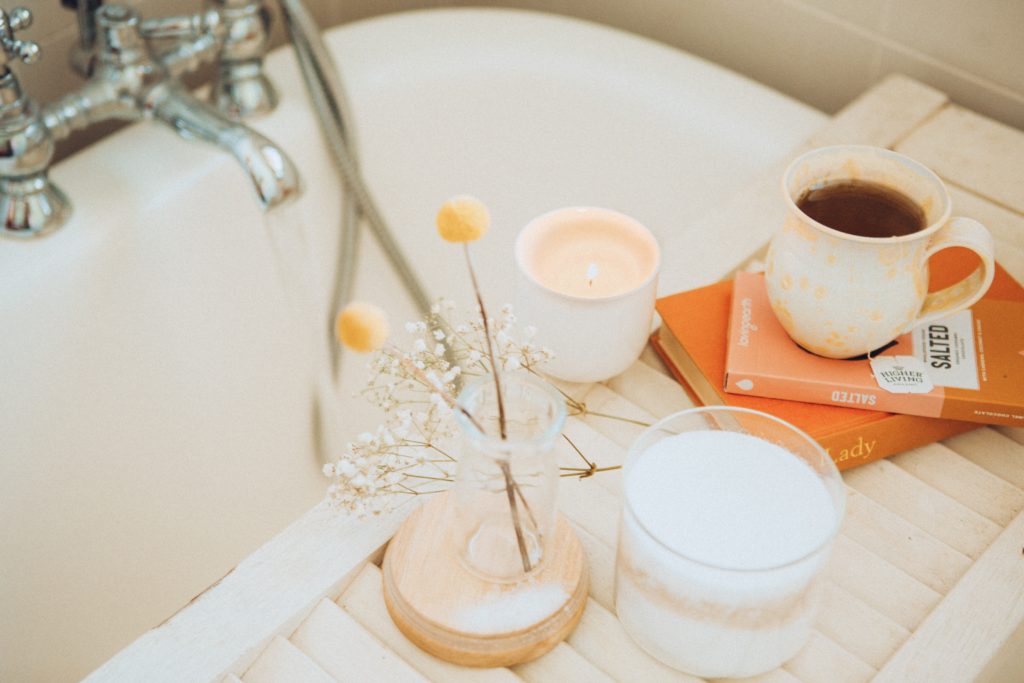What Are Self-Love Practices
Self-love practices, also known as daily practices or mindful practices, aren’t limited to meditation and journaling. They can be any activity that connects you further with yourself. Sometimes, it’s simply a thing that creates a break in mental chatter or space between you and your challenges. Having self-care practices at your disposal is a healthy way to gain perspective. In this post, we’ll also discuss some benefits of self-love practices.
Here’s a list of common and less common ways to practice self-love:
- Setting Boundaries — with roommates, coworkers, family, or even yourself
- Traveling and/or Changing Scenery
- Movement — Walking, Biking, Yoga, Dancing, Pole Dancing, etc.
- Journaling
- Meditating
- Taking Breaks
- Going to Bed Early
- Having a Nightly Skincare Routine
- Keeping Your Space Tidy
- Time in Nature
- Reading
- Having a Favorite Health Drink or Snack
- Limiting Screen Time
- And More!
From this list, know that you don’t need to do everything. Just pick one or two or add your own. Making it an activity you truly enjoy is a great way to show yourself you care and to help it stick.
The Benefits of Practicing Self-Love
Your relationship with yourself will be the longest one of your lifetime. By re-learning how to love yourself, you’ll make this journey a far more comfortable one. So a huge benefit is being your own cheerleader.
“When a woman becomes her own best friend life is easier.”
― Diane Von Furstenberg

Another benefit to practicing self-love and, in turn, mindfulness is a decrease in time spent in unwanted emotional states like anxiety. A discovery made in a public medical journal stated that “One of the consequences of extensive mindfulness practice is a reduction of anxiety and depression, but also a capacity to regulate negative emotions.”
The Power of Being Adaptable
Each day holds unique challenges. Just like no two sunsets are the same, no two days are the same. Because of this, we get to have many ways to love ourselves.
What you need and when you need it will be different sometimes. For example, maybe you have extended family over for the holidays and you’re overwhelmed. Self-care that day may look like taking space for yourself in the quiet of nature.
But now imagine you’ve been working alone from home on a deadline all day. When you finally finish, going to see friends or family might sound better than being alone in nature.
The beautiful thing to discover is that it’s safe to listen to that voice—the little one who knows what’s best for you.
Helping New Habits to Stick
Three simple ways to help these new practices become regular parts of your life are to:
- Pair the practice with another well-formed habit you already have.
For example, if you already drink coffee every morning, add your journaling practice to your coffee ritual. It’s easier to lump practices with things that you are sure not to miss than it is to reinstate something brand new.
- Make the experience fun and playful
Don’t use self-care as another opportunity to punish yourself, instead keep it light. If the practice is something you love to do, it makes it more likely you’ll return to it.
Three Benefits of Journaling
Journaling is a powerful tool for healing and getting more involved in your inner world. Since it’s such an adaptable and useful practice, we wanted to highlight some rewards for picking up your old journal once again.
Your journal and how you format it are completely up to you. You can make it a historically accurate list of the events of the day. You can make it a place where you write down your dreams, your weird thoughts, and even the things that are annoying you. It can be a freeform notebook full of drawings, thoughts, lists, stickers, whatever you want.
- Brings awareness
Being aware is the first step. Dr. Jill Bolte Taylor, a brain researcher, discovered that emotions only last 90 seconds due to them just being a chemical reaction. What this means is if you could acknowledge that you are upset or sad or disappointed and sit with that feeling, it would pass more quickly than if you kept denying it or pretending to feel differently than you actually do.
By writing down what you’re feeling, you validate your experiences. Having it written down means you can see your habits and growth from another perspective. It also gives you another space to practice self-responsibility.
- Express your emotions
A common reason for depression or numbness is not feeling like you have a safe space to express yourself. What journaling offers is a safe space to release emotions and a way to give yourself permission for expression.
It may feel weird at first, but as you practice, you will grow more comfortable with your feelings because you’re giving them the freedom to roam on the page.
- Practice self-compassion
“That’s why self-compassion and courage are vital. Staying with pain without loving-kindness is just warfare.”
—Pema Chödrön
Self-compassion is the practice of holding yourself exactly as you are in love and acceptance. Self-compassion feels very different from its opposite, which is self-judgment.
When journaling, you get to see yourself, your struggles, and what you’ve been carrying from a bird’s eye view. Having compassion for yourself is essential on the journey to healing, otherwise, this journey becomes one of self-punishment. And you’ve learned the hard way that punishing yourself doesn’t work. Self-compassion is a better way—a gentler way.
Click here for journaling prompts.

Choose Your Self-Care Activity Based on Your Cycle
For women, another way to determine what sort of activity to do is to take into account where you are at in your menstrual cycle. Read our article on cycles and seed cycling if you’d like more information on this.
A brief way of explaining your cycle is to connect it with the seasons. There are four phases of the menstrual cycle:
- Menstruation — Winter
- Follicular — Spring
- Ovulation — Summer
- Luteal — Fall
The follicular stage is when your body is preparing to release eggs in preparation for a potential pregnancy. Ovulation is when your egg is released. These are referred to as the spring and summer, respectively. During your spring and summer stages, you may feel more active and social.
Right after ovulation is a phase called the luteal phase. Estrogen levels drop and progesterone production increases, causing fatigue, sensitivity, cravings, and a call to go inward. Due to the luteal phase and menstruation being more inward times, these are compared to fall and winter. They are times that your body is shedding the old.
- Spring — After your period ends to just before ovulation
- Energy rebuilds
- Increased happiness
- Great time for new beginnings
- Summer — During ovulation
- The highest amount of energy
- Creative energy peaks
- Extroverted
- Fall — Start of Luteal Phase
- Progesterone drops
- Energy levels begin to fall
- PMS Symptoms can begin
- The body starts to want slowness
- Winter — Menstruation
- Time to go inward
- Shed the old + make space for the new
- Avoid rigorous exercise
End Notes
By building this connection with yourself, the hope is that one day most of the things that make up your day are activities that nourish you.
Before you go, we have big news! This summer, we’re launching Roadmap to Anxiety Relief, a course to further support those who suffer from anxiety and are ready to flip the script. Click here to join the email list and be the first to hear when it’s ready!
As always, I’m here to support you and be a trusted friend along this journey. Your personal women’s health coach. If you’d like to learn more about working with me, click here.
If you found this information valuable, please let us know in the comments your favorite part.

